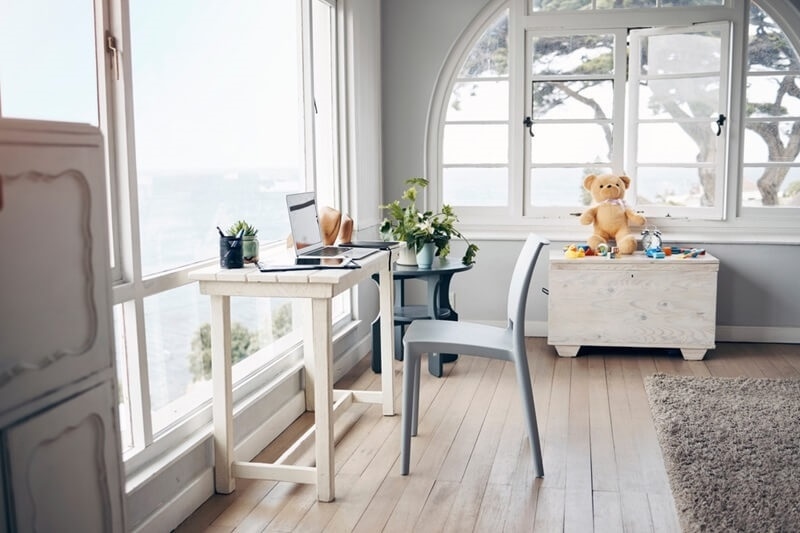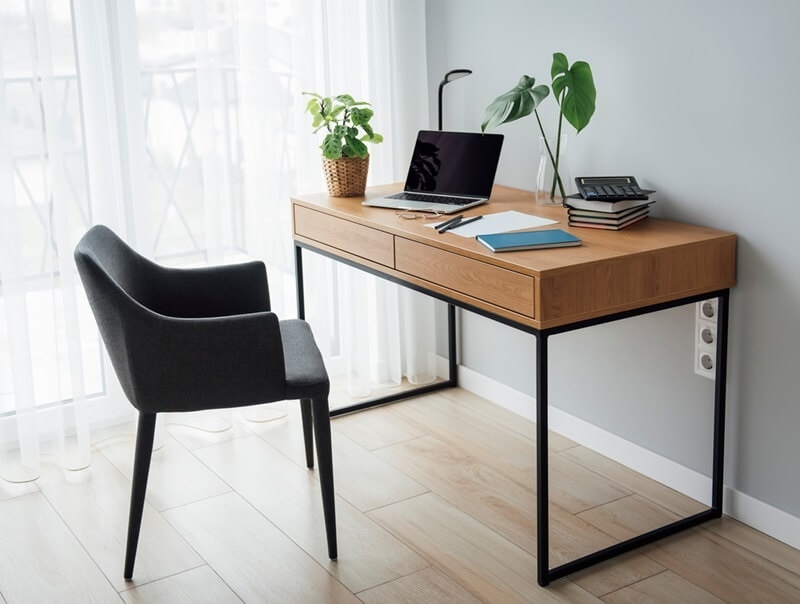
In today's world of working from home, your productive home office set-up isn't just to have a desk and chair; it's to create a tailored, personalized space to promote well-being while helping you to achieve your goals. You can efficiently execute daily tasks, manage projects, and attend meetings virtually; however, the make-up of your space will play a role in your success.
Home office design with a focus-friendly layout and clever ergonomic desk ideas has been shown to help improve concentration, lower stress, and help keep you on track during your workday. Even if you have a small space or don't have much of a budget, budget home office ideas can help you design a space that is productive and inspiring. Let's jump into the most effective methods for home workspace setup that enhance focus and comfort.
A good workspace is more than just looks. Research indicates that a well-organized, ergonomic home office setup can boost productivity up to 20%. Without a defined work area, distractions intrude, posture is compromised, and motivation dwindles.
The home office arrangement for productivity is not a universal recipe. It will differ depending on your work style, home design, and type of work. For remote workers, the secret is to emulate a professional atmosphere that facilitates concentration without sacrificing the comforts of home.

Designing the ideal work-from-home environment for remote employees combines comfort, functionality, and technical preparedness. Here are some essential points to keep in mind:
If you're lucky enough to have an extra room, fantastic. Otherwise, find a quiet nook that's distraction-free. The area should enable you to demarcate work from home life, no matter how symbolic.
Fast Wi-Fi, noise-canceling headphones, a good webcam, and two monitors can make you work smarter. Technical problems will kill productivity quicker than anything.
Natural light not only prevents eye strain but also increases mood and alertness. Position your desk in front of a window if you can.
A clean environment allows your brain to maintain focus. Use drawer dividers, wall shelves, or pegboards to keep things out of the way yet within reach.
When considering ergonomic desk ideas, both comfort and posture are at the forefront. Poor configurations can lead to long-term health issues like back strain, neck tension, or carpal tunnel syndrome.
A sit-stand desk helps you switch between sitting and standing, enhancing circulation and minimizing fatigue.
Invest in a back-support chair with height adjustment and armrests. Keep your feet flat on the ground, and your elbows should be at a 90-degree angle while typing.
The monitor must be placed at eye level and at arm's length to prevent eye fatigue. Employ risers or monitor stands if needed.
Your mouse and keyboard should be positioned in such a way that your wrists are in a straight line. A wrist rest can offer extra support.
A focus-friendly home office design minimizes mental overload and keeps you mentally active. Here are tested strategies:
Employ sound-absorbing curtains, rugs, or even a white noise machine to minimize sound distractions. Whenever possible, shut your door during working hours to convey boundaries.
Colors affect your mood. Blue shades improve concentration, and green encourages relaxation. Use these colors through wall paint, decor, or office accessories.
Houseplants clean the air, lower tension, and create a nice aesthetic. Even a tiny snake plant or succulent can create a more welcoming and healthier space.
A focused task light cuts down on eye strain, particularly if you work in the evenings. Choose adjustable lamps with warm white light to add comfort.
Not everyone has a big room or budget; however, that doesn’t stop you from having a productive space. Here are some small home office ideas on a budget that you can use to set yourself up:
Find an old table and use it as a desk. Take a bookshelf and use it for storage. Before you buy anything brand new, be sure to think about ways you can reimagine what you already have.
Search Pinterest, where you will find some great options for DIY wall decor, cork boards, templates for pen holders, all under $10, that will elevate the vibes in your space.
Using floating shelves from Ikea and Amazon is great, as it will use existing wall space as well as keep your work surface clear and user-friendly.
You can find desks that not only have drawers already but also fold up. Storage ottomans and small filing cabinets are great in tight spaces.
The physical setup of your home office is just half the battle; you need a routine and discipline to be productive in your home office workspace.
Start every workday with a quick workspace reset—clear your desk, prioritize, and maybe do a quick mindfulness exercise or stretches.
Maintain regular working hours to draw lines. Inform family or roommates of your times to reduce disruptions.
Employ methods such as the Pomodoro technique (25 minutes of work, 5 minutes of break) to remain alert and concentrated throughout the day.
Visual clutter often invites mental clutter. Here are some storage options that will keep clutter managed and your space clean:
Keeping a clean space should help you stay true to your focus-friendly home office design and aid in staying focused.
Adding in personal touches makes your home office a representation of your space while still maintaining your professional productivity goals:
Hang encouraging quotes or calming artwork that is associated with your goals and mindset.
Create a visual board of career goals, milestones, or motivational images to encourage you to keep moving forward.
You can create a calming ambiance with essential oil diffusers or scented candles in lavender or eucalyptus.
Most remote workers overlook these common mistakes in their home office setup:
In addition to setting your home office for maximum productivity, the right tools can keep your workflow and productivity seamless.
Establish a strict no-distraction rule for your home office area. Disable mobile alerts, shut off social media during the day, and place snacks or personal items out of reach. This physical and psychological demarcation isolates your mind in "work mode." You can go so far as to set up a simple sign on your door that reads “Do Not Disturb—Working” to remind others in the home not to disturb you. These unwritten boundaries are most important to mastering your home office arrangement for productivity and a consistent flow of work during the day.
A carefully planned home office setup for productivity does not need to break the bank. By prioritizing layout, ergonomics, personalization, and routine, you can create a space that keeps distractions at bay and motivation at high levels. Whether you're implementing small home office ideas in a budget-friendly way, incorporating ergonomic desk ideas, or honing a focus-friendly home office design, the end goal is the same—build a workspace that aids your health, efficiency, and peace of mind.
Set your intention, put these real-world tips into action, and turn your home into a productivity powerhouse and cozy retreat.
This content was created by AI